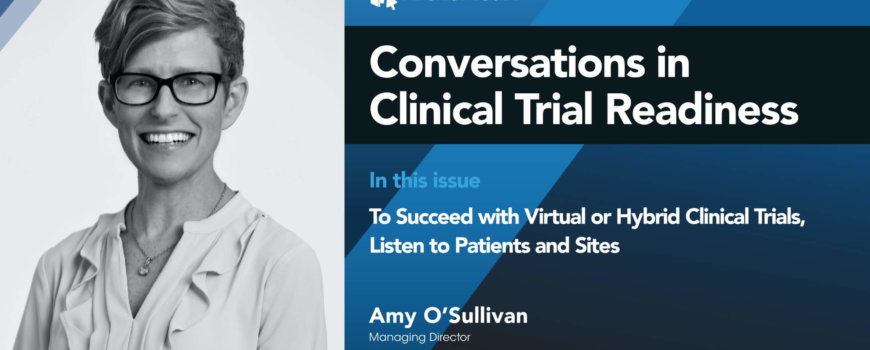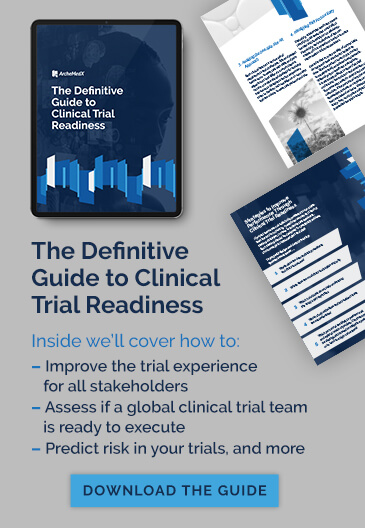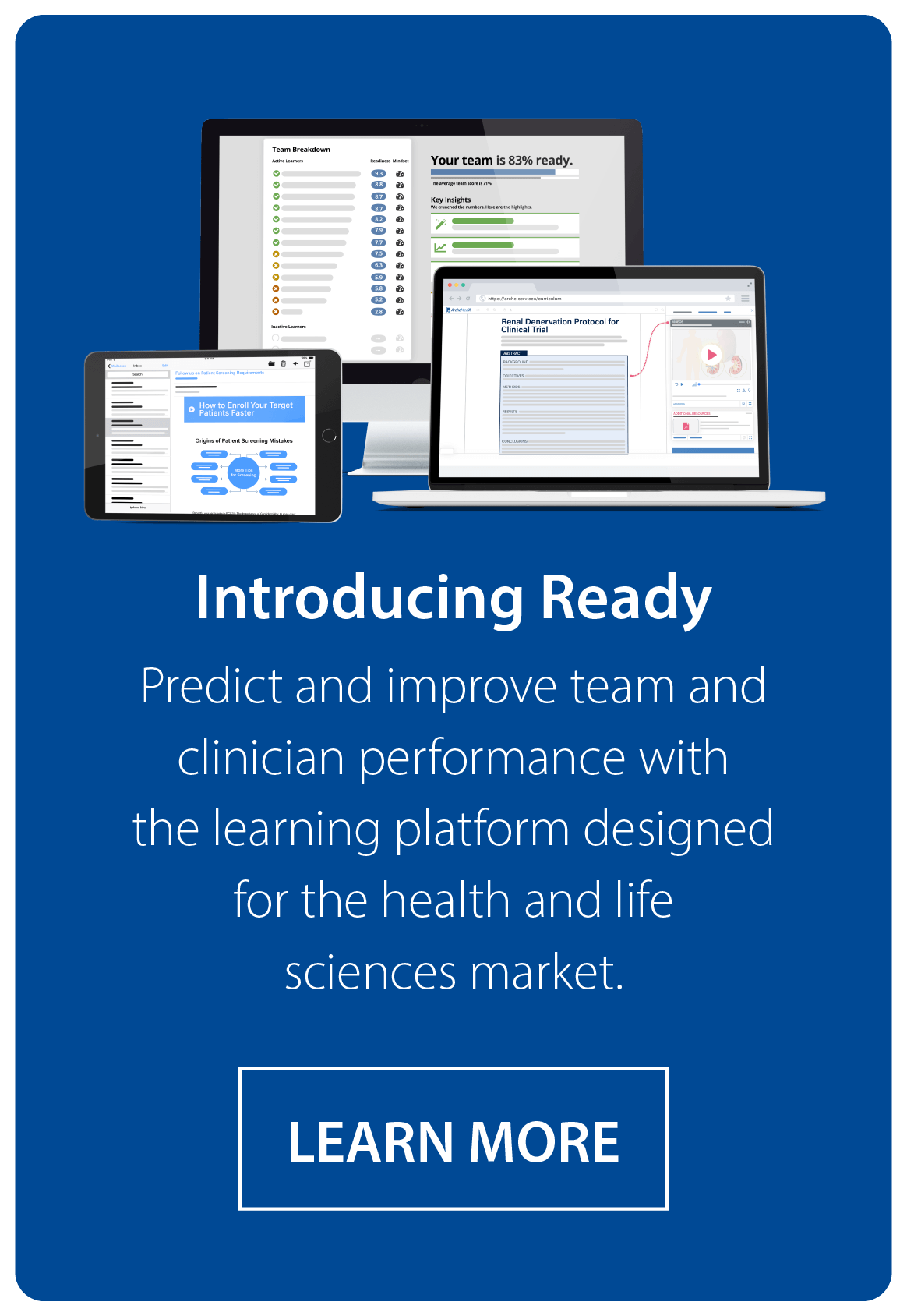 We recently spoke about virtual and hybrid clinical trials with Amy O’Sullivan, Director of North American Operations at SCOPE International, an independent full-service CRO serving pharma, biotech, and medical device clients across the US and Europe. The company is headquartered in Mannheim, Germany, with US operations based in Pittsburgh, PA. Here are some of the most interesting excerpts from our discussion:
We recently spoke about virtual and hybrid clinical trials with Amy O’Sullivan, Director of North American Operations at SCOPE International, an independent full-service CRO serving pharma, biotech, and medical device clients across the US and Europe. The company is headquartered in Mannheim, Germany, with US operations based in Pittsburgh, PA. Here are some of the most interesting excerpts from our discussion:
ArcheMedX:
You’ve had such an interesting career – spanning social services, nursing, site coordination, and managing programs. Tell us about where your current career is focused.
O’Sullivan:
So much right now is attached to the experience of the pandemic. But even before COVID hit, my interest has been, “how can we do what we do better?” The way we perform clinical trials has been stagnant for a long time. Yes, new tools have emerged, but none have truly been transformational. But considering R2 and Risk-Based Monitoring, there’s really a ton of potential, it just needed an accelerator.
Though the pandemic has been horrible, it has accelerated the transformation that was needed. So my focus has been – and will continue to be – clinical trial innovation so we can bring clinical trials to people across all parts of the country and the globe. You shouldn’t need to live near a big city to be able to participate in a trial and get the most innovative treatments. We should be able to have a diverse population because we can bring trials to patients, and even bring them to patient’s homes. So these have been driving forces.
ArcheMedX:
So how do you approach this transformation?
O’Sullivan:
To be able to do things that are more creative, I’ve been collaborating with eSystems partners and sites that are willing to step forward. What we have now is a way to run fully virtual clinical studies when needed, or hybrid clinical trials when appropriate. We can focus on quality, by focusing on the risks that matter. We can monitor in a way that makes sense, let sites use their resources to take care of their patients, and have monitors provide support to the sites because they’re not spending every hour of their day checking data points, but instead checking what matters, and helping sites deliver the best experience to the patient.
Because that’s what it’s all about – clinical trials succeed when sites are able to succeed and we listen to patients and what they need. Especially virtual, hybrid, or decentralized clinical trials.
Transformation is my focus. It’s been a long time in coming. If we’re going to bring more treatments to market faster, innovation is not an option.
ArcheMedX:
Tell us more about the strategies that you’re using for virtual and hybrid clinical trials that could work for organizations who don’t know where to start.
O’Sullivan:
The place to start – what do subjects and sites need? You can’t just jump into virtual or hybrid clinical trials and choose what to virtualize casually. You need to be thoughtful – it needs to make sense. There are dozens or hundreds of eSystems out there – whether they solve a problem for you is what matters.
You need to look at your protocol to see what you really need. When do you really need the patient there and when do you not? And the answer for that needs to be driven by the physician on the front line, because they know what they will be comfortable doing. So you have to listen, you can’t just decide from the 30,000 foot level of the Sponsor or the CRO.
Part of what we’ve done at SCOPE is we’ve been developing relationships with various sites that say they do virtual research or want to do virtual or hybrid clinical research. We’ve been listening to them and gathering from them inputs about what works and what doesn’t. In parallel, we’ve been working with some sites that are willing to innovate to understand what they really need to do to shift. Because a fully virtual clinical trial is actually a very tough thing to run.
Ultimately, you must go to the physicians and to the sites, and listen to the patients – then select the eSystems that really facilitate the process.
ArcheMedX:
What are the specific challenges you see with virtualizing clinical trials?
O’Sullivan:
You don’t have everyone under one roof. So you have to ask, what are the impacts? One of the biggest impacts is that you can’t physically touch a patient. You need to know if you truly need the physical exam or not. Don’t pretend you can do something virtually that you can’t.
If you can do that virtually, then you need a telemedicine solution that is going to work for you and that is cost-effective, because some solutions may be cost-prohibitive.
Another challenge is adjusting for a lack of travel. We discovered that the more that is eSourced, the less that has to be checked into the EMR. So we have partnered with one eSource company in particular, so that people can do their job remotely. A physician who is working remotely can log into an eSource tool, log a contact note, and move on. We’ve eliminated multiple steps.
You have to make things digital, and simple, and eliminate those middle steps that are unnecessary.
ArcheMedX:
We spoke earlier about how clinical trial Sponsors want to make the study startup digital. So much of startup is training. What strategies do you use in how you help your Sponsors train and equip clinical trial teams?
O’Sullivan:
This is something we’ve had to pivot. When you move from the in-person investigator meeting, or the in-person SEV or SIV meeting, there’s a lot of things you can do hands on. You can read people’s faces, and people were demonstrating their understanding in ways that we didn’t even realize was happening until we went virtual.
We have a lot of sites that are semi-virtualized out of necessity, and a trial team that’s the same. We have a huge number of eSystems, and we’ve pivoted to a risk-based model. This idea of just presenting a Powerpoint and saying “this is how you do it” – it just doesn’t work.
There are so many nuances; you need to know 3 or 4 eSystems, and how to cross-reference them. And the thought that a half-hour Powerpoint presentation is going to make that clear is just untrue. And what that results in is a large likelihood of early errors and site questions, and it’s understandable. You can’t expect someone to have a nuanced understanding of all of these systems.
So what we’ve moved to is return demonstration. You have to teach the way you know people learn. You retain about 20% of what you hear, and maybe 40% on a good day, but the point at which you have to actually show someone what to do, that’s when it sticks.
It means that when we’re doing our SIVs we’re moving away from Powerpoints, we’re watching to make sure they’re logging in and walking through. If you don’t, you’re going to get a phone call because you didn’t teach them well enough.
That’s something you can do well when you’re on-site but it’s something many aren’t doing well in a remote setting.
And this is one of the most intriguing things – when you get the same question from multiple sites, you can see what in your training material is not good enough. If say, 25% of sites are struggling with something that is a critical teaching point, we can modify that content and redeploy it. The data that comes out of that is precisely where we want to go.
As eSystems grow, the need for this grows exponentially.
You can target what critically matters. Every protocol has a pressure point. And those making sense is a must, you don’t want those pressure points to get lost in a presentation.
ArcheMedX:
If we dig into the remote investigator meeting, or training clinical trial site staff, what are the real problems you’ve seen emerging?
O’Sullivan:
People are comfortable and they want to stick with what they’re used to. If you can get over the mindset of change, it’s very solvable.
When you virtualize – whether training, or anything else – it needs to be interactive. When you’re in person, you know who’s paying attention and who isn’t. It may be as simple as expecting everyone to have their camera on. You have to be able to “read the room” to know that people are engaging as you would around the table.
The first few months of COVID it was really basic; we had to get people to step back and say, “this is not a temporary change – I need to embrace this.” That’s been 60-70% of it. And if you have a good platform for meetings, and everyone is using it and talking, it doesn’t have to be that different.
And in some ways, we can be more available. A year ago, I didn’t do face to face meetings with sites – but now, I do virtually. And that’s a positive thing.
ArcheMedX:
I think you’re right – many people were very resistant to shifting to virtual meetings at first. Did you find that clinical trial sites struggled to change?
O’Sullivan:
Moving to the virtual and remote world – sites were uncomfortable for a very good reason. More burden was put on the site. They were expected to do more, but support wasn’t put in place. Sites are coming along as we’re able to make things easier for sites.
CROs were making it burdensome and there was pushback because patients were more important than the CRO’s processes. But what we’ve been able to do is allow them to have on-demand support – like letting them show us the lab kit and ask where to place a sticker, or pulmonary function test and taking equipment out of the box and walk through how to use it. We have to not just say we’ll do it, but make it your business model – be more supportive through virtual meetings.
ArcheMedX:
So the solution to virtualization in clinical trials really boils down to support.
O’Sullivan:
It comes down to support, and the fact that you’re providing solutions. Don’t just employ bells and whistles because they appeal to you and you like the idea of them. Do something because it works.
ArcheMedX:
What would be your advice for clinical operations leaders in the next six months?
O’Sullivan:
Embrace the progress and the innovation that has come because of the pandemic. We all have to live through the horror, but there has been really great progress. We’ve become more patient-centric, and more site-centric. We’ve been able to use innovation to deliver to a much broader population. Be willing to persist, and don’t revert.
I was just in a meeting, and we ended with “what do end users need to be able to able to their job well?” We constantly ask, what do users need to do their job well, so they can enroll fast, and activate fast. When we put proposals together, we believe that Sponsors will embrace this thinking. It will increase quality and drive down costs. If you improve quality, trust that cost will reduce accordingly.
Focus on patient and site needs, and success will follow. I believe that whole-heartedly. It’s always been Sponsors telling CROs, CROs telling sites, sites telling patients…that’s a completely wrong approach. Focus on patients, and focus on site needs and success will follow. And that’s how we will find the path forward to success with decentralized and hybrid clinical trials today – and virtual trials in the future.
ArcheMedX:
Amy points to the need for Sponsors and CROs to focus not just on what sites are doing, but how best to enable and support them. One way to do so is to employ tools that translate site activities into intelligence – that reveals where the sites are struggling. Learn more about our platform, Ready, and how it can help you as you begin to embrace hybrid or decentralized clinical trial activities.





